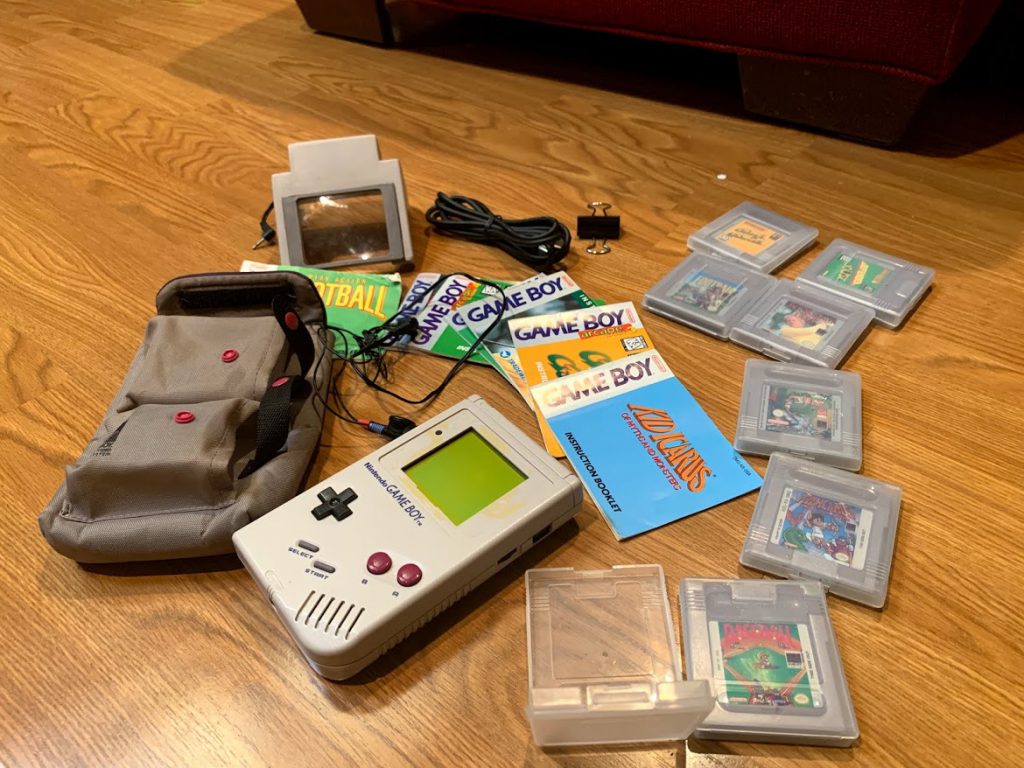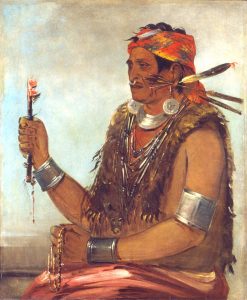Chances are that at one point or another in your life, you have heard of Nintendo. The company of Nintendo launched in Japan in 1889 as a card game company. However, Nintendo is now a video game company. As pinball machines gave way to electronic video games, the toy industry sought to take video games into the home with console games that plugged into televisions. The next step was to be able to take the game along for the ride. With that in mind, Nintendo created a gaming system then called the Game Boy.1
Gunpei Yokoi developed Nintendo Game Boy. The first version of the Nintendo Game Boy was made in 1989 and “offered a Z80 processor, a green LCD screen, and a gray hard-shell body.”2 The Nintendo Game Boy was one of the first handheld video game consoles. Roughly the size of a paperback book, the Game-boy utilized game cartridges and greyscale dot-matrix graphics.3 The Nintendo Game Boy was paired with a game called Tetris, a tile-based puzzle game, which made the Nintendo Game Boy an instant success.4 When the Nintendo Game Boy released in Japan, 300,000 units sold. A few months later, the Game Boy was released in the United States on July 31, 1989. The development of Nintendo Game Boy did not stop after its release, but the gaming unit went through many changes over a ten year period.5

While there were other handheld video game consoles on the market, the Game Boy was one of the first to feature interchangeable cartridges. Other handhelds only had one pre-installed game. In other words, if you wanted to play different games, you had to purchase separate consoles. My mother’s family talks about going on camping trips with the cousins’ football and baseball handheld video games, which was just about all there was at the time before the Game Boy. The Game Boy allowed the user to purchase one console and multiple (sometimes hundreds) of game cartridges. Not only was this a new idea, but it was a very profitable one as well.
Not only did Game Boy users purchase game cartridges, they also bought all sorts of accessories. Users needed cases to carry their console and cartridges. They purchased gadgets to magnify the screen. They also purchased gadgets to use the console in low light conditions due to no backlighting for the Game Boy. And, of course, users sought to upgrade to the next best console as Nintendo continued to develop new products.
One of the many modifications to the Nintendo Game Boy was the Mini-Arcade. The Mini-Arcade turned a user’s Game Boy into a table top game. It included a miniaturized version of the joystick which was used in other standard gaming consoles.6 The Mini-Arcade addition made the Nintendo Game Boy something that people could use as a table top game if the user so desired.
Another modification that the Nintendo Game Boy has gone through is having different colors of casing. By 1995, users had a choice of body colors for their Nintendo Game Boys.7 One option included the “Play It Loud” colors. Play It Loud was a campaign that showed different colors they offered for the Game Boy. The different colors that “Play It Loud! units were manufactured were red, green, black, yellow, white, blue, and clear.”8 The clear or transparent Game Boy, sometimes called X-Ray, could be found in the UK during this time. One source describes, “The most common Game Boy colors included yellow, red, clear and black. The Green Game Boy were fairly scarce but blue and white are the rarest.”9 There were other accessories that Nintendo put out such as a printer and a camera in 1995. They also toyed around with a 16-bit version the same year the printer and camera accessories were out and considered making a touch pad adapter three years after.10
A third revision to the Nintendo Game Boy was the Game Boy Pocket, which was released on July 21, 1996. The Game Boy Pocket boasted a version that was smaller and lighter when compared to the original Game Boy. Advertisements highlighted the fact that this console could fit in your pocket. Another advantage of the console was that the gaming cartridges were interchangeable with the original Game Boy. Unlike the original Game Boy, which required 4 AA batteries to function, the Game Boy Pocket only required 2 AAA batteries to function. While the Game Boy Pocket required fewer batteries to function, it could only provide the user of the console with about ten hours of game play compared to the original Nintendo Game Boy which yielded about fifteen hours of game play.11 With the Nintendo’s many revisions and iterations such as the Game Boy Pocket and Game boy Color, the Game Boy sold over 118 million units worldwide.12

Another revision was the Game Boy Light, released in Japan on April 14, 1998, which was only available in Japan. The Game Boy Light was a console that was slightly bigger than the Game Boy Pocket. The Game Boy Light offered a feature that the previous versions of the Game Boy did not have which was “an electroluminescent back light for low-light conditions.”13 The Game Boy Light requires 2 AA batteries to function providing the user of the console with about twenty hours of game play without the electroluminescent back light on and twelve hours of game play with the electroluminescent back light on. The Game Boy Light had two standard colors, gold and silver. It also has “numerous special editions, including an Astro Boy edition…, an Osamu Tezuka World edition with a clear red case and a picture of his characters, and a solid yellow Pokemon Center Tokyo version.”14
The Game Boy Color is yet another version of the Game Boy, which was released in Japan on October 21, 1998, and a month later, it hit the international markets. Compared to the other versions of the Nintendo Game Boy the Game Boy Color had a screen that could display images in color. Unlike the Game Boy Light, which had a electroluminesent back light to use in low-light conditions, the Game Boy Color did not have one. The Game Boy Color required 2 AA batteries for providing the user with 10 hours of game play. The Game Boy Color also utilized backwards compatibility, featuring the ability to play gaming cartridges originally developed for the original Game Boy and Game Boy Pocket. Unique colors of this version of the Game Boy included berry (fuchsia), grape (purple), kiwi (neon green), dandelion (yellow), and teal. Two other options sold at the same time were called Atomic Purple, which was a translucent purple color, and Neotones Ice which was a clear casing that was only sold in Japan. The original Game Boy and the Game Boy Color sold about 118 millions unit worldwide.15

The Game Boy Advanced SP was yet another version of this system, and it was released in February 2003. The Game Boy Advanced SP included a screen that could show pictures in color, a front light which could be used in low light conditions, and a clam shell design to protect the screen from getting damaged or dirty. The clam shell design was also used in the Nintendo DS, which was released in November 2004. The Game Boy SP had a rechargeable battery, which took three hours to recharge, provided the user with 18 hours of gameplay without the light on and 10 hours of gameplay with the light on. Compared to the other Game Boy consoles that came before it, the consoles that came after the Game Boy Advanced SP had better, more colorful graphics, gaming mechanics were made more complex by adding voice control and touch screen, and games with more moving parts could be more easily covered.16
The Nintendo Game Boy was not the only handheld gaming console to accommodate various game cartridges, but it was by far the most popular and longest lasting. Atari and Sega both introduced handheld consoles, but they were not able to innovate to the level that Nintendo could. Nintendo continues to dominate the world of the full-size video game industry while incorporating online gaming. While handheld consoles are not as popular due to the proliferation of smartphones, the Game Boy influenced app-based games and ingrained the idea that we can take the game with us.
- “Nintendo of America Inc.,” in Company Profiles for Students, edited by Donna Craft and Amanda Quick, Vol. 2. (Detroit, MI: Gale, 1999)950-954. ↵
- Elizabeth Rholetter Purdy, “Gameboy,” in St. James Encyclopedia of Popular Culture, 2nd ed., edited by Thomas Riggs, Vol. 2. (Detroit, MI: St. James Press, 2013), 420. ↵
- “Nintendo of America Inc.,” In Company Profiles for Students, edited by Donna Craft and Amanda Quick, 950-954, Vol. 2. Detroit, MI: Gale, 1999. ↵
- Roberto Dillon, The Golden Age of Video Games: The Birth of a Multi-Billion Dollar Industry (Boca Raton, Fla. : A K Peters/CRC Press, 2011), 164-165. ↵
- Wikipedia, 2019, s. v. “Game Boy,” https://en.wikipedia.org/wiki/Game_Boy. ↵
- Elizabeth Rholetter Purdy, “Gameboy,” In St. James Encyclopedia of Popular Culture, 2nd ed., edited by Thomas Riggs, 420. ↵
- Elizabeth Rholetter Purdy, “Gameboy,” In St. James Encyclopedia of Popular Culture, 2nd ed., edited by Thomas Riggs, 420. ↵
- Wikipedia, 2019, s. v. “Game Boy,” https://en.wikipedia.org/wiki/Game_Boy. ↵
- Wikipedia, 2019, s. v. “Game Boy,” https://en.wikipedia.org/wiki/Game_Boy. ↵
- Jeff Ryan, Super Mario: How Nintendo Conquered America (New York: Penguin, 2011), 207-208. ↵
- Wikipedia, 2019, s. v. “Game Boy,” https://en.wikipedia.org/wiki/Game_Boy. ↵
- Roberto Dillon, The Golden Age of Video Games: The Birth of a Multi-Billion Dollar Industry (Boca Raton, Fla.: A K Peters/CRC Press, 2011), 164-165. ↵
- Wikipedia, 2019, s. v. “Game Boy,” https://en.wikipedia.org/wiki/Game_Boy. ↵
- Wikipedia, 2019, s. v. “Game Boy,” https://en.wikipedia.org/wiki/Game_Boy. ↵
- Wikipedia, 2019, s. v. “Game Boy Color,” https://en.wikipedia.org/wiki/Game_Boy_Color. ↵
- Wikipedia, 2019, s. v. “Game Boy Advanced SP,” https://en.wikipedia.org/wiki/Game_Boy_Advance_SP ↵



41 comments
Mauro Bustamante
This article brought back lots of memories as a child, my sister used to have one of Nintendo Game Boy. It amazing on how far technology has changed throughout he years since then, I mean now we have Nintendo making controls separate to where two people can play on one tiny scene outside of their home; Nintendo switch. I do not think that anybody would have predicted or even imagined how fast technology in hand held consoles would advance. Nintendo is amazing company who really developed their technology over the years for many to enjoy. This article was a great read and really brought back a lot of memories.
Charli Delmonico
My brother and I have always owned Nintendo consoles which we used to play popular games, and I simply miss those fun times. This article really brought back fun memories that I had with my older brother. I had no idea that Nintendo started off with such a ground-breaking console. I guess I had figured that other consoles had rivaled it, but apparently not. They still have incredibly popular gaming consoles that are sold in so many countries.
Thalia Romo
This article was really interesting to read because it really showed the affect that hand-held video games had on society and the amount of growth technology has had over the past few decades. Growing up, I didn’t get the chance to experience what it was like owning a Nintendo Game Boy, however my dad owned one so I would play a Mario 64 game that was still in there. It was so much fun and an easy thing to keep you occupied. The amount of tech knowledge that I learned from this article is great!
Kelsey Sanchez
I really enjoyed reading this article! I and my brother grew up playing video games on a Nintendo and Gameboy. We also owned a joystick, which was super fun because we had many options of games to choose from. I would say they were and still are a fun way to stay entertained. I am really surprised by the way the Nintendo is changing and there are new games that are coming out. I feel that they will always stay popular no matter what. Great article!
Isabella Torres
The Gameboy was a huge part of my childhood and reading this article really brought me back. I never really realized how many different versions and upgrades there have been over the years. It has advanced so much more than I expected which I find really interesting. I like how this article gave details about each version of the Gameboy and how it went in chronological order.
Todd Brauckmiller Jr.
This article brought back a lot of great memories, old memories of my childhood. The game boy brought so much fun to many kids around the world and gave so much inspiration for other games to come to life. Personally I enjoyed the nintendo DS and spent countless hours playing games with my friends. Great job on this article, really reminded me of the old days.
Jose Maria Llano Aranalde
Really good article. It brings back so many memories from playing with my own game boy when I was younger. It is really impressive that Nintendo was one of the first companies to make hand held devices. They were the one that started everything. It is also very interesting to see how far they have come since then.
Roberto Rodriguez
I did not realize the very long history of the Game Boy, the humble beginnings of the Game Boy and how many versions that Nintendo had of the Gameboy. It is really interesting to see how far we have advanced, especially when you think of Nintendo’s current hand held console, the Switch, compared to their first Game Boy. I do not think that anybody would have predicted or even imagined how fast technology in hand held consoles would advance.
Eliezer Leal
What a great article. I remember having a gameboy as a child, the gameboy was my introduction to the video game world. To this day I own a game, every time I use it, it brings back so many joyful memories and a sense of nostalgia. The gamebot truly revolutionized the world of video games and was a great invention.
Judy Reyes
This was a great topic to talk about. When I was little, my sisters and I had a Nintendo Game Boy. They were amazing! It was crazy how the change in technology once lead them to have cameras and even be touch screen. Now, they came out with the Switch, it is a handheld device that you can take on the go and also connect to your tv! Nintendo is a successful company that youth and even adults love today!